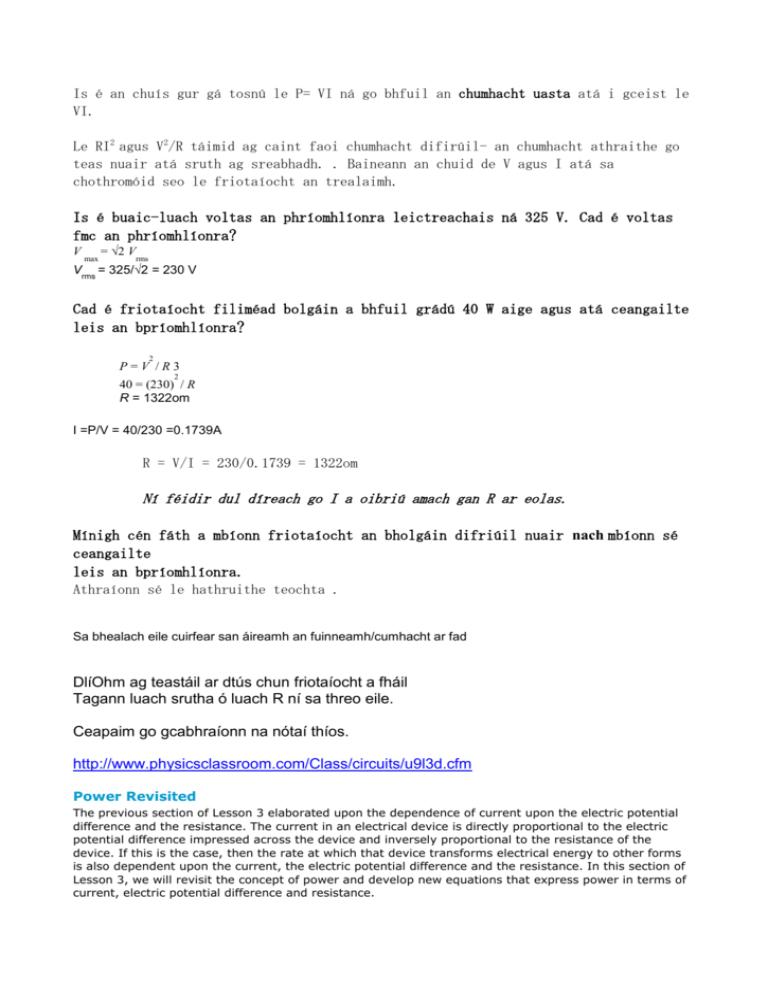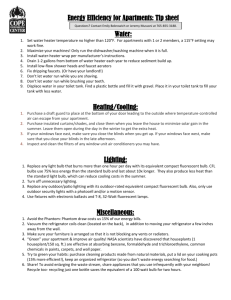Is é an chuís gur gá tosnú le P= VI ná go bhfuil an chumhacht uasta
advertisement

Is é an chuís gur gá tosnú le P= VI ná go bhfuil an chumhacht uasta atá i gceist le VI. Le RI2 agus V2/R táimid ag caint faoi chumhacht difirúil- an chumhacht athraithe go teas nuair atá sruth ag sreabhadh. . Baineann an chuid de V agus I atá sa chothromóid seo le friotaíocht an trealaimh. Is é buaic-luach voltas an phríomhlíonra leictreachais ná 325 V. Cad é voltas fmc an phríomhlíonra? V max = √2 V rms Vrms = 325/√2 = 230 V Cad é friotaíocht filiméad bolgáin a bhfuil grádú 40 W aige agus atá ceangailte leis an bpríomhlíonra? 2 P=V /R3 2 40 = (230) / R R = 1322om I =P/V = 40/230 =0.1739A R = V/I = 230/0.1739 = 1322om Ní féidir dul díreach go I a oibriú amach gan R ar eolas. Mínigh cén fáth a mbíonn friotaíocht an bholgáin difriúil nuair nach mbíonn sé ceangailte leis an bpríomhlíonra. Athraíonn sé le hathruithe teochta . Sa bhealach eile cuirfear san áireamh an fuinneamh/cumhacht ar fad DlíOhm ag teastáil ar dtús chun friotaíocht a fháil Tagann luach srutha ó luach R ní sa threo eile. Ceapaim go gcabhraíonn na nótaí thíos. http://www.physicsclassroom.com/Class/circuits/u9l3d.cfm Power Revisited The previous section of Lesson 3 elaborated upon the dependence of current upon the electric potential difference and the resistance. The current in an electrical device is directly proportional to the electric potential difference impressed across the device and inversely proportional to the resistance of the device. If this is the case, then the rate at which that device transforms electrical energy to other forms is also dependent upon the current, the electric potential difference and the resistance. In this section of Lesson 3, we will revisit the concept of power and develop new equations that express power in terms of current, electric potential difference and resistance. New Equations for Power In Lesson 2, the concept of electrical power was introduced. Electrical power was defined as the rate at which electrical energy is supplied to a circuit or consumed by a load. The equation for calculating the power delivered to the circuit or consumed by a load was derived to be (Equation 1) The two quantities that power depends upon are both related to the resistance of the load by Ohm's law. The electric potential difference ( V) and the current (I) can be expressed in terms of their dependence upon resistance as shown in the following equations. V = (I • R) I= V/R If the expressions for electric potential difference and current are substituted into the power equation, two new equations can be derived that relate the power to the current and the resistance and to the electric potential difference and the resistance. These derivations are shown below. Equation 2: P= V•I Equation 3: P= V•I P = (I • R) • I P = V • ( V / R) P = I2 • R P = V2 / R We now have three equations for electrical power, with two derived from the first using the Ohm's law equation. These equations are often used in problems involving the computation of power from known values of electric potential difference ( V), current (I), and resistance (R). Equation 2 relates the rate at which an electrical device consumes energy to the current at the device and the resistance of the device. Note the double importance of the current in the equation as denoted by the square of current. Equation 2 can be used to calculate the power provided that the resistance and the current are known. If either one is not known, then it will be necessary to either use one of the other two equations to calculate power or to use the Ohm's law equation to calculate the quantity needed in order to use Equation 2. Equation 3 relates the rate at which an electrical device consumes energy to the voltage drop across the device and to the resistance of the device. Note the double importance of the voltage drop as denoted by the square of V. Equation 3 can be used to calculate the power provided that the resistance and the voltage drop are known. If either one is not known, then it will be important to either use one of the other two equations to calculate power or to use the Ohm's law equation to calculate the quantity needed in order to use Equation 3. While these three equations provide one with convenient formulas for calculating unknown quantities in physics problems, one must be careful to not misuse them by ignoring conceptual principles regarding circuits. To illustrate, suppose that you were asked this question: If a 60-watt bulb in a household lamp was replaced with a 120-watt bulb, then how many times greater would the current be in that lamp circuit? Using equation 2, one might reason (incorrectly), that the doubling of the power means that the I2 quantity must be doubled. Thus, current would have to increase by a factor of 1.41 (the square root of 2). This is an example of incorrect reasoning because it removes the mathematical formula from the context of electric circuits. The fundamental difference between a 60-Watt bulb and a 120-Watt bulb is not the current that is in the bulb, but rather the resistance of the bulb. It is the resistances that are different for these two bulbs; the difference in current is merely the consequence of this difference in resistance. If the bulbs are in a lamp socket that is plugged into a United States wall outlet, then one can be certain that the electric potential difference is around 120 Volts. The V would be the same for each bulb. The 120-Watt bulb has the lower resistance; and using Ohm's law, one would expect it also has the higher current. In fact, the 120-Watt bulb would have a current of 1 Amp and a resistance of 120 ; the 60-Watt bulb would have a current of 0.5 Amp and a resistance of 240 . Calculations for 120-Watt Bulb Calculations for 60-Watt Bulb P= V•I P= V•I I=P/ V I=P/ V I = (60 W) / (120 V) I = (120 W) / (120 V) I = 0.5 Amp I = 1 Amp V=I•R V=I•R R= V/I R= V/I R = (120 V) / (0.5 Amp) R = (120 V) / (1 Amp) R = 240 R = 120 Now using equation 2 properly, one can see why twice the power means that there would be twice the current since the resistance also changes with a bulb change. The calculation of current below yields the same result as shown above. Calculations for 120-Watt Bulb P = I2 • R Calculations for 60-Watt Bulb P = I2 • R I2 = P / R I2 = P / R I2 = (120 W) / (120 ) I2 = 1 W / I = SQRT ( 1 W / I = 1 Amp I2 = (60 W) / (240 ) I2 = 0.25 W / ) I = SQRT ( 0.25 W / I = 0.5 Amp )







